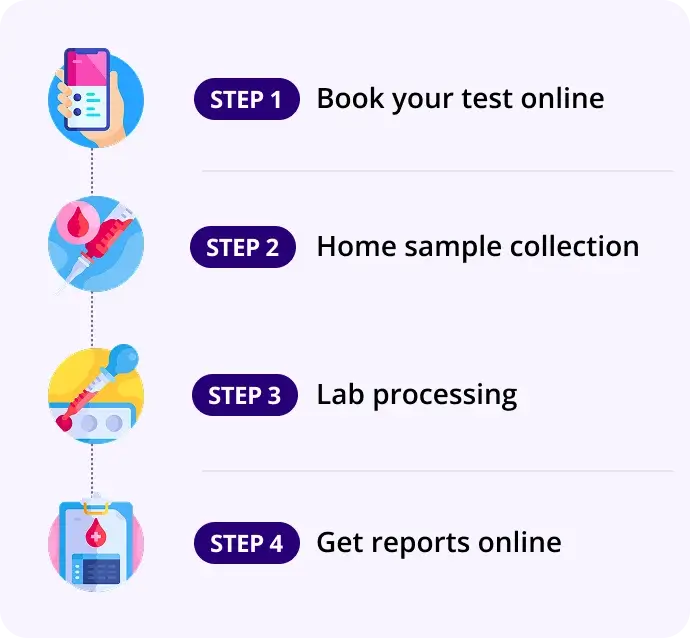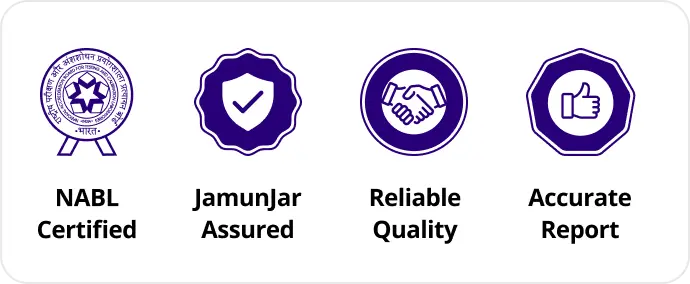Fructosamine
Report in 36Hrs
At Home
No Fasting Required
Details
Evaluate glucose levels in patients with conditions affecting hemoglobin (e.g., anemia, hemoglobinopathies) where HbA1c may be inaccurate
₹1199₹1455
18% OFF
🧪 What is Fructosamine?
Fructosamine is a compound formed when glucose binds to serum proteins, primarily albumin. It reflects the average blood glucose levels over the past 2–3 weeks, which is shorter than the 2–3 month window provided by HbA1c.
- Since albumin has a shorter half-life than hemoglobin (~20 days vs ~120 days), fructosamine is useful for monitoring recent changes in glycemic control.
❓ Why is the Fructosamine Test Done?
To:
- Monitor short-term glycemic control in people with diabetes
- Assess glucose control during pregnancy (e.g., gestational diabetes)
- Evaluate glucose levels in patients with conditions affecting hemoglobin (e.g., anemia, hemoglobinopathies) where HbA1c may be inaccurate
- Track response to therapy changes or lifestyle interventions
- Use in patients on dialysis or with shortened RBC lifespan
📊 Normal Range
Parameter | Normal Range |
|---|---|
Fructosamine | 200 – 285 µmol/L (may vary by lab) |
🔍 Optimal target values may vary depending on individual glycemic targets. Diabetic patients under good control usually have values around < 285–320 µmol/L.
📈 Interpretation of Results
Fructosamine Level | Interpretation |
|---|---|
<200 µmol/L | May suggest hypoglycemia or overly tight control |
200–285 µmol/L | Normal or well-controlled diabetes |
>285–350 µmol/L | Moderate hyperglycemia |
>350 µmol/L | Poor glycemic control; likely sustained high blood glucose over the last 2–3 weeks |
🧠 Associated Organs and Conditions
Organ/System | Relevance |
|---|---|
Liver | Produces albumin, the main protein measured for fructosamine |
Pancreas | Glucose control depends on insulin secretion |
Kidneys | Chronic kidney disease can affect protein turnover |
Blood (RBCs) | Fructosamine is not affected by RBC disorders, unlike HbA1c |
⚠️ Factors That Can Affect Fructosamine Levels
- Low albumin levels (e.g., liver disease, nephrotic syndrome) → false low fructosamine
- High albumin turnover (e.g., thyroid disease, acute illness) → altered results
- Recent dietary or medication changes → can reflect rapidly in fructosamine vs HbA1c
🔄 Related / Follow-Up Tests
- HbA1c – For long-term glycemic control (2–3 months)
- Fasting Blood Glucose (FBG)
- Postprandial Glucose (PPG)
- Random Blood Sugar (RBS)
- Albumin / Total Protein – Helps interpret fructosamine accuracy
- Insulin levels or C-peptide – In type 2 diabetes assessment
✅ Fasting Required?
Parameter | Requirement |
|---|---|
Fasting Required? | ❌ No fasting required for fructosamine testing |
✅ Can be drawn any time of day, and is unaffected by recent meals.
📝 Summary
Parameter | Summary |
|---|---|
What | Measures glycated serum proteins, reflecting average glucose over the past 2–3 weeks |
Why Test | To monitor short-term glycemic control, especially when HbA1c is unreliable |
Normal Range | 200 – 285 µmol/L |
High Values | Suggest poor short-term glucose control |
Low Values | May indicate tight control or hypoglycemia |
Follow-up Tests | HbA1c, FBG, PPG, albumin, insulin/C-peptide |
Fasting Required | ❌ No |
How our test process works!

